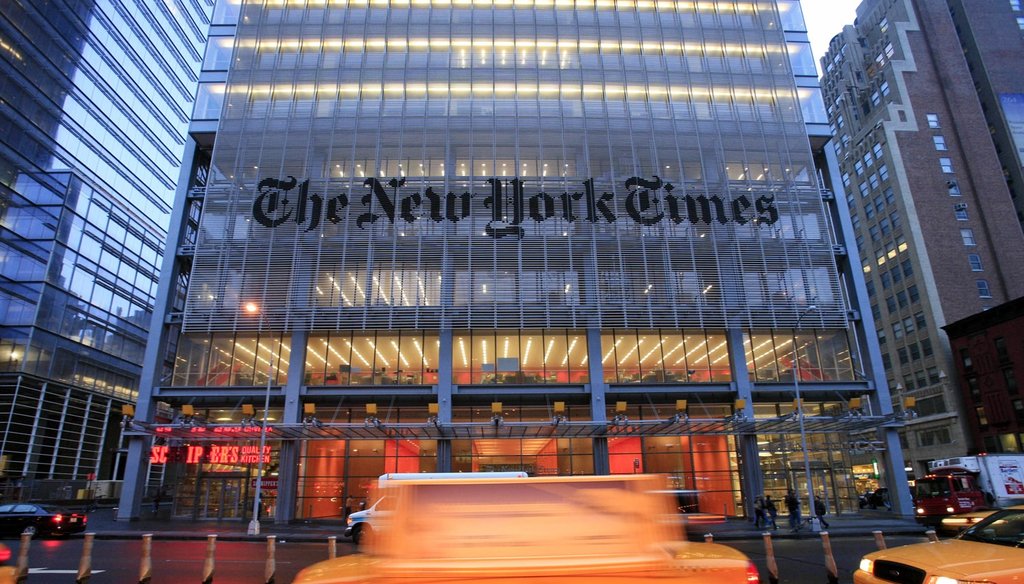Stand up for the facts!
Our only agenda is to publish the truth so you can be an informed participant in democracy.
We need your help.
I would like to contribute

In this April 21, 2009 file photo, the New York Times headquarters is shown in New York. (AP)
The conservative publication PJ Media says in a headline spreading virally on Facebook that the New York Times admitted a new allegation against Justice Brett Kavanaugh is "fake news," but that is misleading.
The back-and-forth stems from a Sept. 14 report in the New York Times that contains a previously unreported accusation of sexual impropriety by Kavanaugh while a student at Yale.
After its initial reporting, the New York Times added more information to its story online and published an editor’s note explaining its decision.
We’ll walk through what changed in the Times story in a second. But it was not as PJ Media claimed in its headline, "New York Times Now Admits New Kavanaugh Accusation Is Fake News."
"On Sunday, The New York Times added a retraction to its story attacking Brett Kavanaugh, admitting that the female student allegedly assaulted had no recollection of the event. (Writers) Robin Pogrebin and Kate Kelly have egg on their faces," a blurb that ran alongside the PJ Media article reads.
PJ Media’s managing editor Paula Bolyard told us that the PJ Media article was an opinion piece, and said that author Matt Margolis’ use of the phrase "fake news" was a "rhetorical manner of expression." Bolyard noted that other outlets — among them CNN, The Hill and New York Magazine — referred to the New York Times’ update as a "correction."
There are elements of opinion in PJ Media's post, but it’s important for online readers to know that the Times did not retract or reverse its reporting, as PJ Media's headline suggests.
The article in question was adapted from a forthcoming book by New York Times reporters Robin Pogrebin and Kate Kelly, "The Education of Brett Kavanaugh: An Investigation." The book delves into Kavanaugh’s background, including an alleged pattern of sexual misconduct that first came into public view around the time of Kavanaugh’s contentious Oct. 2018 Supreme Court confirmation hearing.
The Sept. 14, 2019, New York Times article "Brett Kavanaugh Fit In With the Privileged Kids. She Did Not" ignited a firestorm, and even led to some Democratic presidential candidates calling for Kavanaugh’s impeachment.
It depicted a previously unreported scene in which Kavanaugh, then a Yale student in the 1980s, was said to have engaged in lewd conduct at a "drunken dorm party." Here’s how the account appears in the New York Times; the bolded section was added after the article’s initial publication:
"We also uncovered a previously unreported story about Mr. Kavanaugh in his freshman year that echoes Ms. Ramirez’s allegation. A classmate, Max Stier, saw Mr. Kavanaugh with his pants down at a different drunken dorm party, where friends pushed his penis into the hand of a female student. Mr. Stier, who runs a nonprofit organization in Washington, notified senators and the F.B.I. about this account, but the F.B.I. did not investigate and Mr. Stier has declined to discuss it publicly. We corroborated the story with two officials who have communicated with Mr. Stier; the female student declined to be interviewed and friends say she does not recall the episode."
And here is the editor’s note the New York Times published Sept. 15, 2019, explaining the change to its story:
"An earlier version of this article, which was adapted from a forthcoming book, did not include one element of the book's account regarding an assertion by a Yale classmate that friends of Brett Kavanaugh pushed his penis into the hand of a female student at a drunken dorm party. The book reports that the female student declined to be interviewed and friends say that she does not recall the incident. That information has been added to the article."
Amid the fallout over its reporting, the Times’ deputy editorial page editor James Dao published written answers to five questions from readers, including a question about why the Times decided to print an allegation that some viewed as insufficiently supported. Here’s how Dao responded:
DAO: "The essay included a previously unreported claim that friends pushed Mr. Kavanaugh’s penis into the hand of a female Yale student during a dorm party with drunken classmates. During the authors’ investigation, they learned that a classmate, Max Stier, witnessed the event and later reported it to senators and to the F.B.I. The authors corroborated his story with two government officials, who said they found it credible. Based on that corroboration, we felt mentioning the claim as one part of a broader essay was warranted."
New York Times spokesperson Danielle Rhoades Ha told PolitiFact the PJ Media headline is "inaccurate," and added that "the editors' note is not a retraction in any way."
As the above text shows, the Times’ explanation may call Stier’s allegation into question. But nowhere does the Times admit it peddled "fake news," which gives the impression of having misled its readers.
For their part, Times’ reporters Kelly and Pogrebin appeared on MSNBC and said the additional details were included in their original draft but were omitted as a result of an editing error. "There was zero intent to mislead anybody about the details of the incident," Kelly said.
Ha, the Times' spokesperson, elaborated on this explanation.
"In the original article editors decided not include some information about a female student at Yale that is provided in Kate Kelly and Robin Pogrebin's book, including her name, in part to protect her privacy because she was not the source for the account in the adaptation," Ha told PolitiFact. "After publication editors agreed with some readers that the adaptation should include the same information as the book, so the piece was updated."
The Times also did not retract the article or the specific allegation against Kavanaugh, as PJ Media said. A retraction would include removing the allegation entirely because it cannot be corroborated. The source of this allegation is Max Stier, a classmate of Kavanaugh’s.
In conclusion, the New York Times said it did not initially publish all relevant information when it ran the article, and the omitted information may call into question the credibility of the accusation. But the Times has since added that information, and wrote an editor’s note explaining their decision.
The Times has not retracted its reporting on the allegation or admitted it was incorrect. Sites claiming so have gone too far.
Our Sources
PJ Media, "New York Times Now Admits New Kavanaugh Accusation Is Fake News," Sept. 16, 2019
New York Times, "Brett Kavanaugh Fit In With the Privileged Kids. She Did Not," Sept. 14, 2019
Mediaite, "Kavanaugh Book Co-Authors Say NYT Editors Cut Key Detail About Alleged Victim Not Remembering the Assault," Sept. 17, 2019
Email interview with Paula Bolyard, managing editor of PJ Media, Sept. 17, 2019
Email interview with Danielle Rhoades Ha, vice president of communications for the New York Times Company, Sept. 17, 2019












































